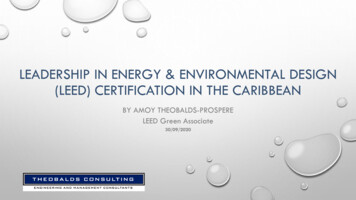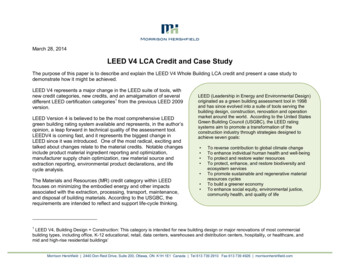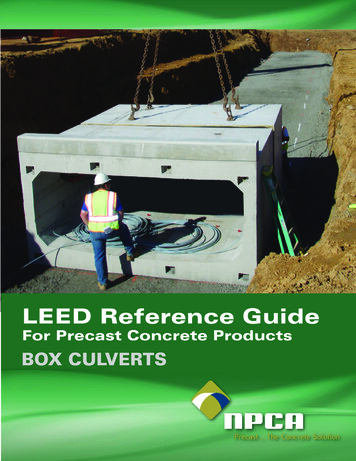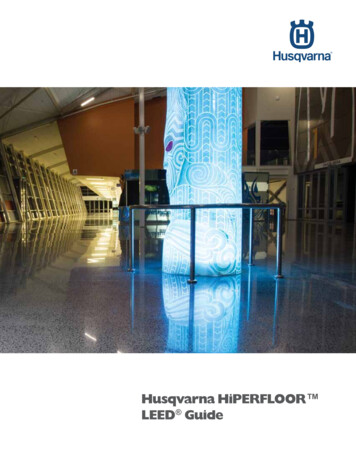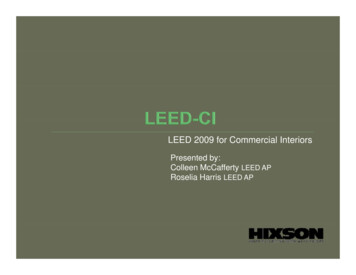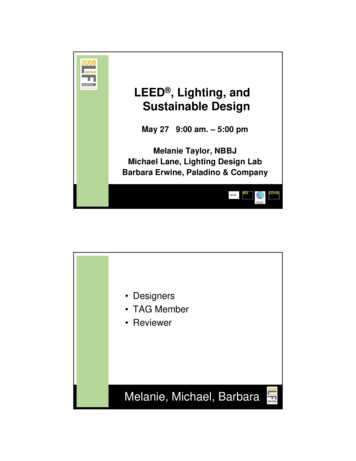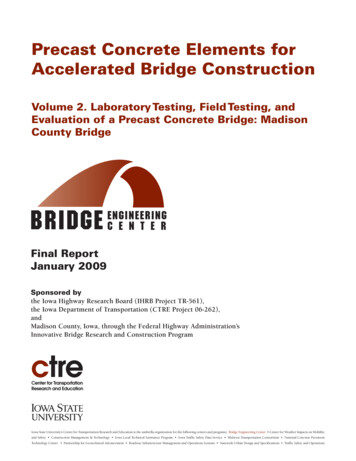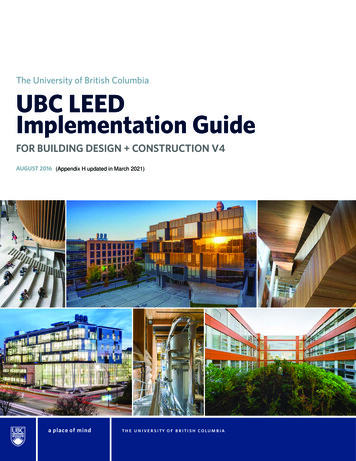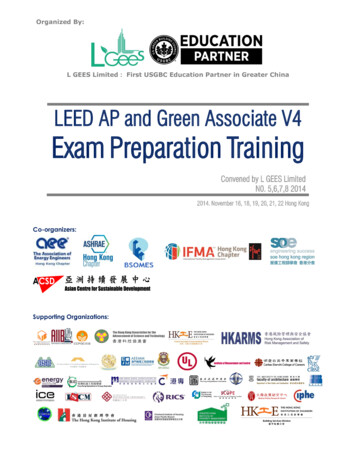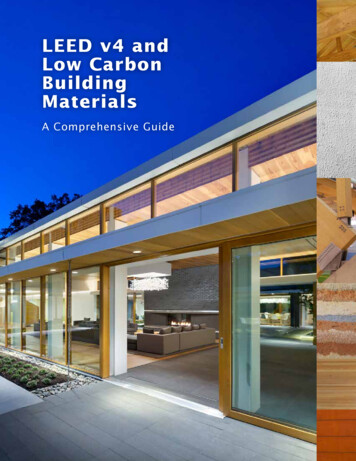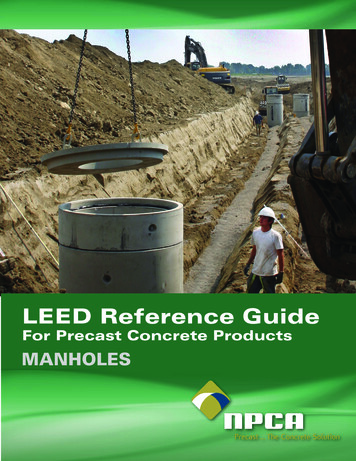
Transcription
LEED Reference GuideFor Precast Concrete ProductsMANHOLES
PRECAST CONCRETE MANHOLESPrecast concrete manholes are an integral component of any modern sewer system. A properly designedand installed precast concrete manhole system provides superior watertight performance compared withcompeting methods and materials. A typical precast concrete manhole can be installed 500 feet deep andmore, because lateral forces act equally around the periphery, which places the section in pure compression –the ideal state for concrete. Precast concrete manhole sections are produced in a controlled environment, sothey exhibit high quality and uniformity of construction.Advantages of Precast Concrete Manholes. 3LEED 2009 – New ConstructionSS 5.1 – Site Development: Protect or Restore Habitat. 4.SS 6.1 – Stormwater Design : Quantity Control. 5SS 6.2 – Stormwater Design : Quality Control . 6MR 4 – Recycled Content . 7MR 5 – Regional Materials. 8LEED 2009 – Neighborhood ConstructionGIB 7 – Minimize Site Disturbance in Design and Construction. 9.GIB 15 – Recycled Content in Infrastructure .10National Precast Concrete Association1320 City Center Dr. Suite 200, Carmel, IN 46032(800) 366-7731 www.precast.orgThis publication is designed to provide accurate and authoritative information in regard to the subject matter covered; however, National PrecastConcrete Association acts as a mediator without approving, disapproving or guaranteeing the validity or accuracy of any data, claim or opinion appearingherein. Information is provided and disseminated with the understanding that the National Precast Concrete Association is not engaged in renderingengineering, legal or any other professional services. If engineering, legal or other professional assistance is required, the services of a competentprofessional should be obtained. The National Precast Concrete Association does not assume and hereby disclaims liability to any person for any loss ordamage caused by errors or omissions in the material contained herein, regardless of whether such errors result from negligence, accident or any othercause whatsoever. The Credit Requirements listed in this document are contained within the Leadership in Energy and Environmental Design GreenBuilding Rating System developed by the United States Green Building Council. For more information on the LEED Green Building Rating System,please visit www.usgbc.org.For additional information about using precast concrete within the LEED system, please visit www.precast.orgLEED 2009 Reference Guide for Precast Concrete Products www.precast.org2
PRECAST CONCRETE MANHOLESAdvantages of precast concrete manholesInstallation is easyPrecast concrete manholes are desirable over castin-place concrete or brick manholes due to ease ofinstallation. Precast concrete manholes can be easilyinstalled on demand and immediately backfilled –there is no need to wait for concrete or mortar tocure at the job site. The size of the excavation maybe smaller for precast as the other methods mayrequire more work space and costly formwork andscaffolding. The degree of soil compaction around themanhole and remaining trenches is never a problem,making installation easier. Contractors are familiarwith how to handle precast concrete manholes andcan easily install them. Standard sealants and flexiblejoints are vital to watertightness.We’re talking quality hereBecause precast concrete products typically aremade in a controlled environment, they exhibit highquality and uniformity. Variables affecting qualitytypically found on a job site – temperature, curingconditions, material quality and craftsmanship – arecontrolled in a precast plant.Rough and toughPrecast concrete strengthens with time, while othermaterials can deteriorate, experience creep andstress relaxation, lose strength and/or deflect overtime. The load-carrying capacity of precast concreteis derived from its own structural qualities and doesnot rely on the strength or quality of the surroundingbackfill materials.Studies have shown that precast concrete productscan provide a service life in excess of 100 years. Forsevere service conditions, additional design optionsare available that can extend the life of the precastconcrete product. This is extremely important whencalculating life-cycle costs for a project.Nasty weather? No problemPrecast concrete increases efficiency becauseweather will not delay production of the manholes.In addition, weather conditions at the job site donot significantly affect the schedule because lesstime is required to install precast compared withother construction materials, such as cast-in-placeconcrete, brick, or plastic and fiberglass products.Watertight – can doASTM C 478, “Standard Specification for PrecastConcrete Manhole Sections,” specifies the propermanufacture of quality, watertight precast concretemanholes. Standard watertight sealants and gasketsare available that are specially designed for use withprecast concrete, making multiple seam precastconcrete manholes very easy to construct. Vacuumtesting is an easy means of verifying watertightness,either in the plant or in the field, as detailed in ASTMC 1244, “Test Method for Concrete Sewer Manholesby Negative Air Pressure (Vacuum) Test.”Will stay on the jobWith a specific gravity of 2.40 and superiorfrictional resistance, precast concrete manholesresist buoyant forces better than all other manholematerials. Fiberglass has a specific gravity of 1.86and HDPE has a specific gravity of 0.97, requiring theuse of tie downs and ultimately increasing projectcosts. With the many advantages over alternativeproducts, precast concrete manholes are clearly thematerial of choice for long-term maintenance-freeconveyance of sewer and stormwater.LEED 2009 Reference Guide for Precast Concrete Products www.precast.org3
PRECAST CONCRETE MANHOLESMANHOLESLEED New ConstructionSS 5.1Sustainable SitesSite DevelopmentProtect or Restore HabitatCredit RequirementMax. Points: 1Site Development – Protect or RestoreHabitatCase 1 – Greenfield SitesLimit all site disturbances to the following parameters: 40 feet beyond the building perimeter 10 feet beyond surface walkways, patios, surface parking andutilities less than 12 inches in diameter 15 feet beyond primary roadway curbs and main utilitybranch trenches 25 feet beyond constructed areas with permeable surfaces(such as pervious paving areas, stormwater detentionfacilities and playing fields) that require additional stagingareas to limit compaction in the constructed area, orCase 2 – Previously Developed AreasRestore or protect a minimum or 50% of the site (excluding thebuilding footprint) or 20% of the total site area (including buildingfootprint area), whichever is greater, with native or adaptedvegetation.Precast ContributionPrecast concrete products are cast andcured in the plant and delivered to thesite ready to set so they reduce thestaging area required, which can reducethe overall site disturbance.The impact on the construction siteis also reduced because there isno additional formwork, which oftenrequires more construction area forabove-ground products and largerexcavation areas for undergroundproducts.Less impact on sites can reduceconstruction waste, shorten theconstruction schedule and require fewerlaborers on-site.See the LEED Canada guide for information on Canada’s creditrequirements.LEED 2009 Reference Guide for Precast Concrete Products www.precast.org4
PRECAST CONCRETE MANHOLESMANHOLESLEED New ConstructionSS 6.1Sustainable SitesStormwater DesignQuantity ControlCredit RequirementMax. Points: 1Stormwater Design – Quantity ControlCase 1: Sites with existing imperviousness 50% or lessOption 1Implement a stormwater management plan that preventsthe postdevelopment peak discharge rate and quantity fromexceeding the predevelopment peak discharge rate and quantityfor the 1- and 2-year 24-hour design storms, orOption 2Implement a stormwater management plan that protectsreceiving stream channels from excessive erosion. Thestormwater management plan must include a stream channelprotection and quantity control strategies.Case 2: Sites with existing imperviousness greaterthan 50%Implement a stormwater management plan that results in a 25%decrease in the volume of stormwater runoff from the 2-year 24hour design storm.Precast ContributionPrecast concrete is an excellentchoice to help control the quantity ofstormwater runoff with a wide variety ofproducts that can contribute to a properstormwater management plan.Precast concrete underground stormsystems are sized to channel largedischarges to nearby bodies of waterduring heavy rains. Precast concretenot only withstands the forces fromfluids inside the pipe, but also handlesextreme loading conditions outside thepipe.Precast concrete manholes are oftenused as part of a storm retentionsystem which helps minimize land use.LEED 2009 Reference Guide for Precast Concrete Products www.precast.org5
PRECAST CONCRETE MANHOLESMANHOLESLEED New ConstructionSS 6.2Sustainable SitesStormwater DesignQuality ControlCredit RequirementMax. Points: 1Quality ControlImplement a stormwater management plan that reducesimpervious cover, promotes infiltration and captures and treats thestormwater runoff from 90% of the average annual rainfall usingacceptable best management practices (BMPs).BMPs used to treat runoff must be capable of removing 80% ofthe average annual postdevelopment total suspended solids (TSS)load based on existing monitoring reports.BMPs are considered to meet these criteria if: They are designed in accordance with standards andspecifications from state or local program that has adoptedthese performance standards, orPrecast ContributionPrecast concrete reinforced manholeshelp control the quality and quantity ofwater in stormwater systems.Precast concrete stormwater structuressuch as manholes are often designedto incorporate flow-through stormwatertreatment systems within theirstructures.These systems can be utilizedto separate sediments and otherpollutants through a swirl flow pattern. There exists infield performance monitoring datademonstrating compliance with the criteria. Data mustconform to accepted protocol for BMP monitoring.LEED 2009 Reference Guide for Precast Concrete Products www.precast.org6
PRECAST CONCRETE MANHOLESMANHOLESLEED New ConstructionMR 4Materials and ResourcesRecycled ContentCredit RequirementMax. Points: 2Recycled ContentRequirementsUse materials with recycled content such that the sum ofpostconsumer recycled content plus 1/2 the preconsumer contentconstitutes at least 10% or 20% (based on cost) of the total valueof the materials in the project. The minimum percentage materialsrecycled for each point threshold is:Recycled Content Points10%120%2The recycled content value of a material assembly is determinedby weight. The recycled fraction of the assembly is then multipliedby the cost of the assembly to determine the recycled contentvalue.Mechanical, electrical and plumbing components and specialtyitems such as elevators cannot be included in this calculation.Include only materials permanently installed in the project.Furniture may be included if it is included consistently in MRCredit 3: Materials Reuse through MR Credit 7: Certified Wood.Precast ContributionPrecast concrete products may containsupplementary cementitious materialssuch as fly ash and blast furnace slagwhich will add to the project’s recycledcontent goals. Precast products mayalso contain rebar and welded wiremesh which is often made fromrecycled steel.Other less frequently used recycledcontent components include variousfiber reinforcements, glass aggregates,silica fume, and recycled crushedconcrete.The NPCA LEED calculator helpsmembers respond with the properdocumentation required for this credit.Simply input the Zip Code/Postal Codeand weight for each component togenerate a pdf file that can be e-maileddirectly to the LEED AP, contractor orarchitect.LEED 2009 Reference Guide for Precast Concrete Products www.precast.org7
PRECAST CONCRETE MANHOLESMANHOLESLEED New ConstructionMR 5Materials and ResourcesRegional MaterialsCredit RequirementMax. Points: 2Regional MaterialsUse materials or products that have been extracted, harvested,and manufactured within 500 miles of the project site.The calculation is based on the overall materials cost. Materialscosts include all expenses to deliver the material to theproject site. Materials costs should account for all taxes andtransportation costs incurred by the contractor but exclude anycost for labor and equipment once the material has been deliveredto the site.Regional Materials of 10% 1 pointRegional Materials of 20% 2 pointsSee the NPCA LEED Calculator at www.precast.org/leed for helpwith this credit.See the LEED Canada guide for information on Canada’s creditrequirements.Precast ContributionBecause concrete uses plentifuland natural raw materials, concretecomponents can be extracted,harvested and manufactured within 500miles of the project site. Using locallyobtained raw materials helps reducetransportation distances which reducesthe environmental impact of carbonemissions.If shipping is done by rail or water,LEED Canada allows up to 2,400km (1,500 miles) from both themanufacturing site to the projectsite and the location where buildingmaterials are extracted, harvested,recovered and processed to themanufacturing site.The NPCA LEED Calculator helpsprovide the proper documentationrequired for this credit. Simply inputthe Zip code where each raw materialoriginates and the weight of eachmaterial to generate a printable filethat can be e-mailed to the LEED AP,contractor or architect.LEED 2009 Reference Guide for Precast Concrete Products www.precast.org8
PRECAST CONCRETE MANHOLESMANHOLESLEED NeighborhoodDevelopmentGIB 7Green Infrastructureand BuildingsMinimized SiteDisturbance in Designand ConstructionCredit RequirementMax. Points: 1Minimized Site Disturbance in Design andConstructionOption 1 – Development Footprint on PreviouslyDeveloped Land:Locate 100% of the development footprint on areas previouslydeveloped, orOption 2 – Undeveloped Portion of Project LeftUndisturbed:Limit disturbance to: 40 feet beyond the building perimeter 10 feet beyond surface walkways, patios, surface parking andutilities less than 12 inches in diameter 15 feet beyond street curbs and main utility branch trenches 25 feet beyond constructed areas with permeable surfacesthat require additional staging areas to limit compaction inthe constructed zone.Precast ContributionPrecast concrete products are plantcast and delivered to the site ready toset so they reduce the staging arearequired which can reduce the overallsite disturbance.The impact on the construction siteis also reduced because there isno additional formwork, which oftenrequires more construction area forabove-ground products and largerexcavation areas for undergroundproducts.Less impact on sites can reduceconstruction waste, shorten theconstruction schedule and require fewerlaborers on-site.Note: This is a condensed version of the credit. The full credit maybe downloaded from USGBG’s Neighborhood Development Guide.LEED 2009 Reference Guide for Precast Concrete Products www.precast.org9
PRECAST CONCRETE MANHOLESMANHOLESLEED NeighborhoodDevelopmentGIB 15Green Infrastructureand BuildingsRecycled Content inInfrastructureCredit RequirementMax. Points: 1Recycled Content in InfrastructureUse materials for new infrastructure such that the sum ofpostconsumer recycled content, in-place reclaimed materials andone-half of the preconsumer recycled content constitutes at least50% of the total mass of infrastructure materials.Count materials in all of the following infrastructure items asapplicable to the project: Roadways, parking lots, sidewalks, unit paving, and curbs Water retention tanks and vaults Base and subbase materials for the above Stormwater, sanitary sewer, energy distribution and waterpipingSee the NPCA LEED Calculator at www.precast.org/leed for helpwith this credit.See the LEED Canada guide for information on Canada’s creditrequirements.Precast ContributionPrecast concrete products may containsupplementary cementitious materialssuch as fly ash and blast furnace slagwhich will add to the project’s recycledcontent goals.Precast products may also containrebar and welded wire mesh whichoften contain recycled steel. Otherless frequently used recycled contentcomponents include various fiberreinforcements, glass aggregates, silicafume, and recycled crushed concrete.Beyond precast products themselves,recycled crushed concrete can alsocontribute to this credit when utilizedas road fill base.LEED 2009 Reference Guide for Precast Concrete Products www.precast.org10
LEED 2009 Reference Guide for Precast Concrete Products www.precast.org MANHOLES LEED New Construction SS 6.1 Sustainable Sites Stormwater Design Quantity Control Credit Requirement Max. Points: 1 Precast Contribution Stormwater Design – Quantity Control Case 1
